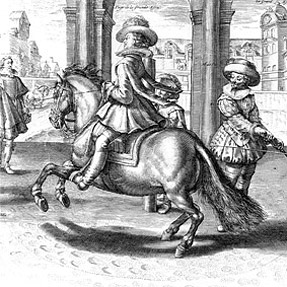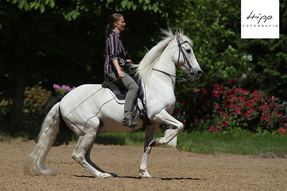|
|||||||||||
|
|||||||||||
| The Renaissance of the Art of Riding History, The Renaissance of the Art of Riding Today, Philosophy HISTORY One who will most certainly have appeared magnificent to Xenophon’s eyes is Antoine Pluvinel, the great French riding master of the Renaissance period. It is through him that the art of equitation reaches new heights in the 16th century. His book „L' instruction du roy en l'exercice de monter à cheval“, in which he teaches Louis XIII of France the art of riding, is not only remarkable for its conciseness and clarity, but also for its educational insight that retains relevance to this day. In the Baroque period the gentry finally withdraws from the battlefields. What was once done for military purposes is now becoming solely an art. François Robinchon de la Guérinière is the great riding master of this age. All the masters in history have one thing in common: they based their work on later usage. This means they studied with great care which parts of the training were the most effective and the most beneficial to the horses’ health. Therefore the art never became artificial. Training the airs on the ground lasted six to eight years, which means that the horses were intended to be used for a long period of time and consequently their health was made a central priority. The 20th century, too, had its share of masters who continued the great tradition: Don Álvaro Domecq Díaz, Don Javier García Romero and Egon von Neindorff. It is from them that my teacher Bent Branderup received his knowledge and experience which he has been passing on to me in the last nine years.
This is the principal objective of the Renaissance of the Art of Riding. Based on “Losgelassenheit”, the horse is formed in line with its physiology and sustains a healthy body when mounted. What starts as a craft can finally become an art – by continually improving the rider’s senses. It is up to the rider’s wisdom how to apply these rules with care and intuition to his horse. Certain things do not have unambiguous rules, since horses are not all alike. Antoine Pluvinel
„It is the rider’s routine using hand and leg aides, paired with an excellent empathy for the horse and a long experience in the art of riding which allow him to resort to a thousand things and more at the right time that cannot be explained or written down but only result from the given situation and necessity. Antoine Pluvinel My training centres on the thought of man and horse being a unity of body and mind. Your education as a person is as important to me as your horse’s education. After all, it’s not only the person training the horse but also the horse training the person, providing you with an opportunity to rediscover physiological senses and perceptive abilities which were taken for granted in a distant epoch but are rarely stimulated today. I made it my personal aim in life to accompany people and horses in the poetic art of academic riding by teaching the principles of an intelligent craft. When the thoughts and movements of rider and horse converge a collective meditation of two living beings occurs. If you take enough time for yourself, your horse and your dreams, you will certainly be able to experience and feel that one day.
|
 Antoine Pluvinel  Elegido Schoolhalt |
